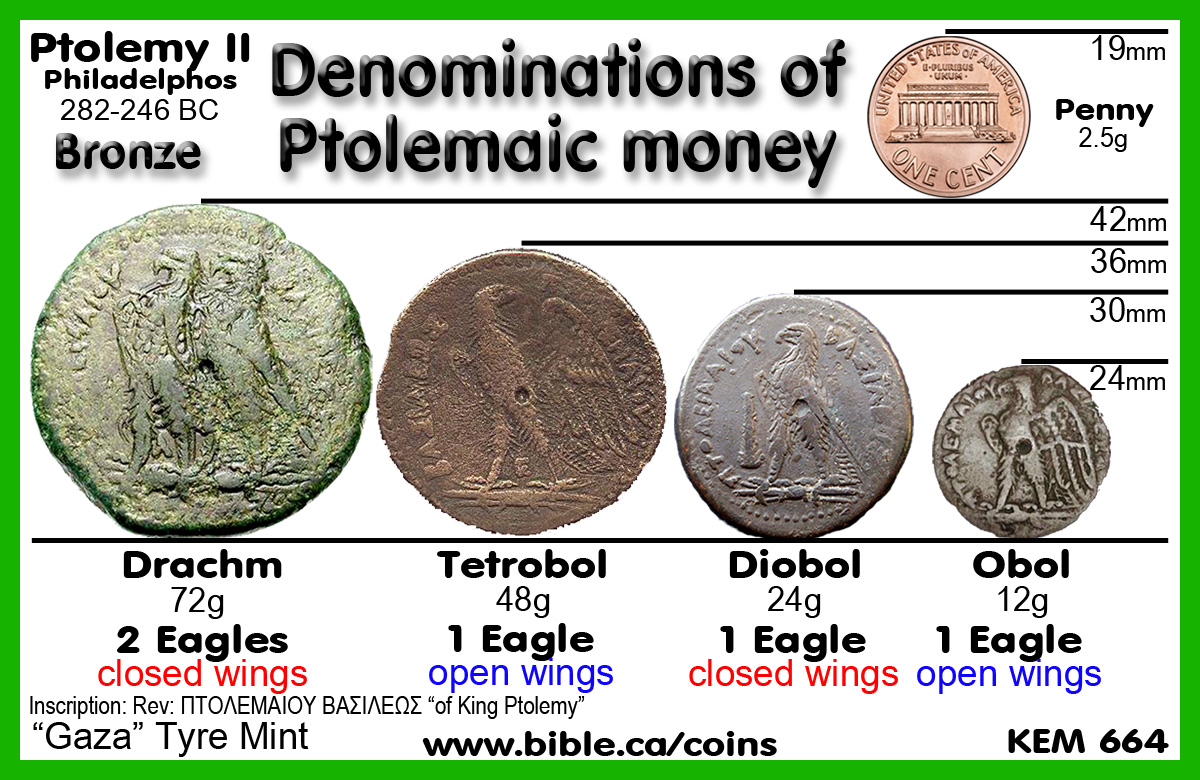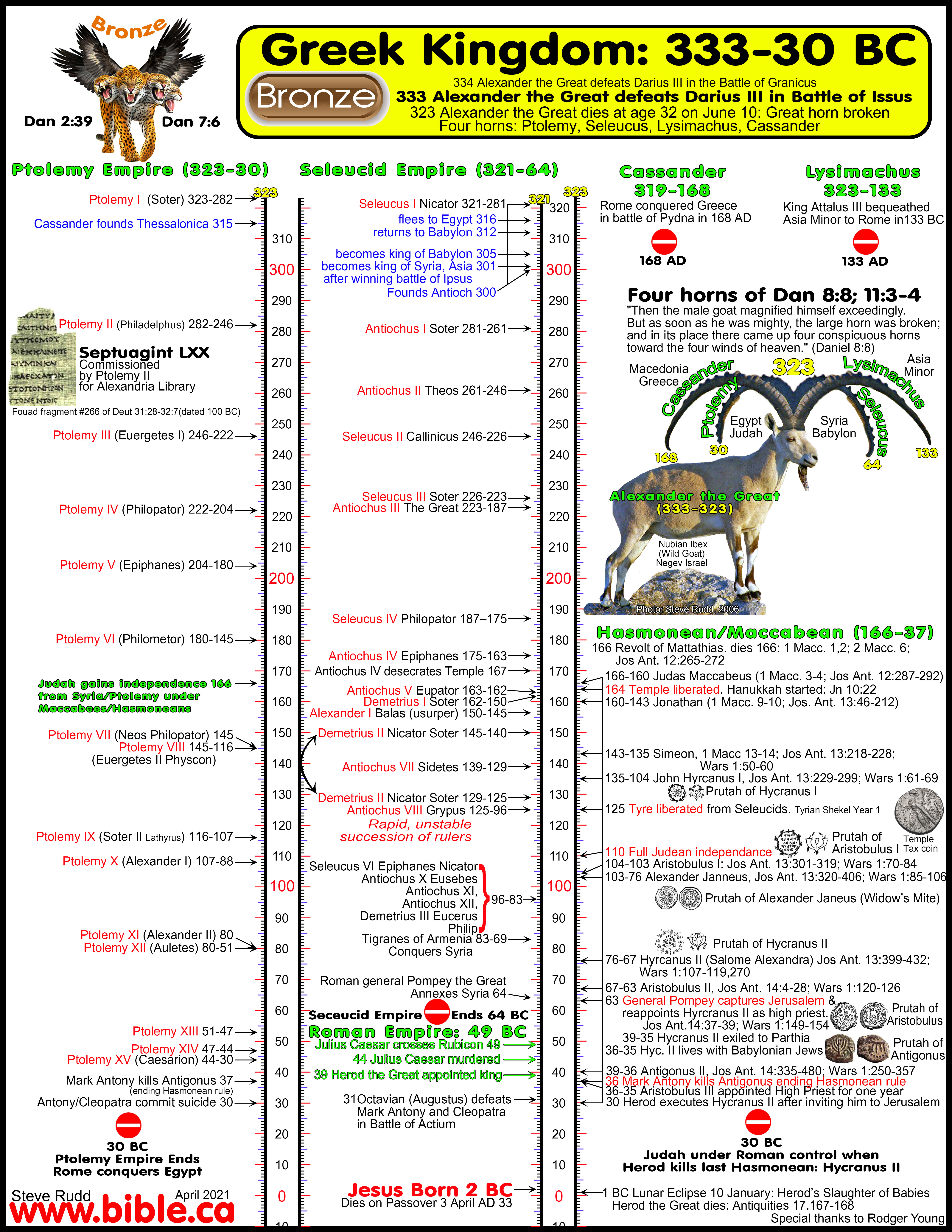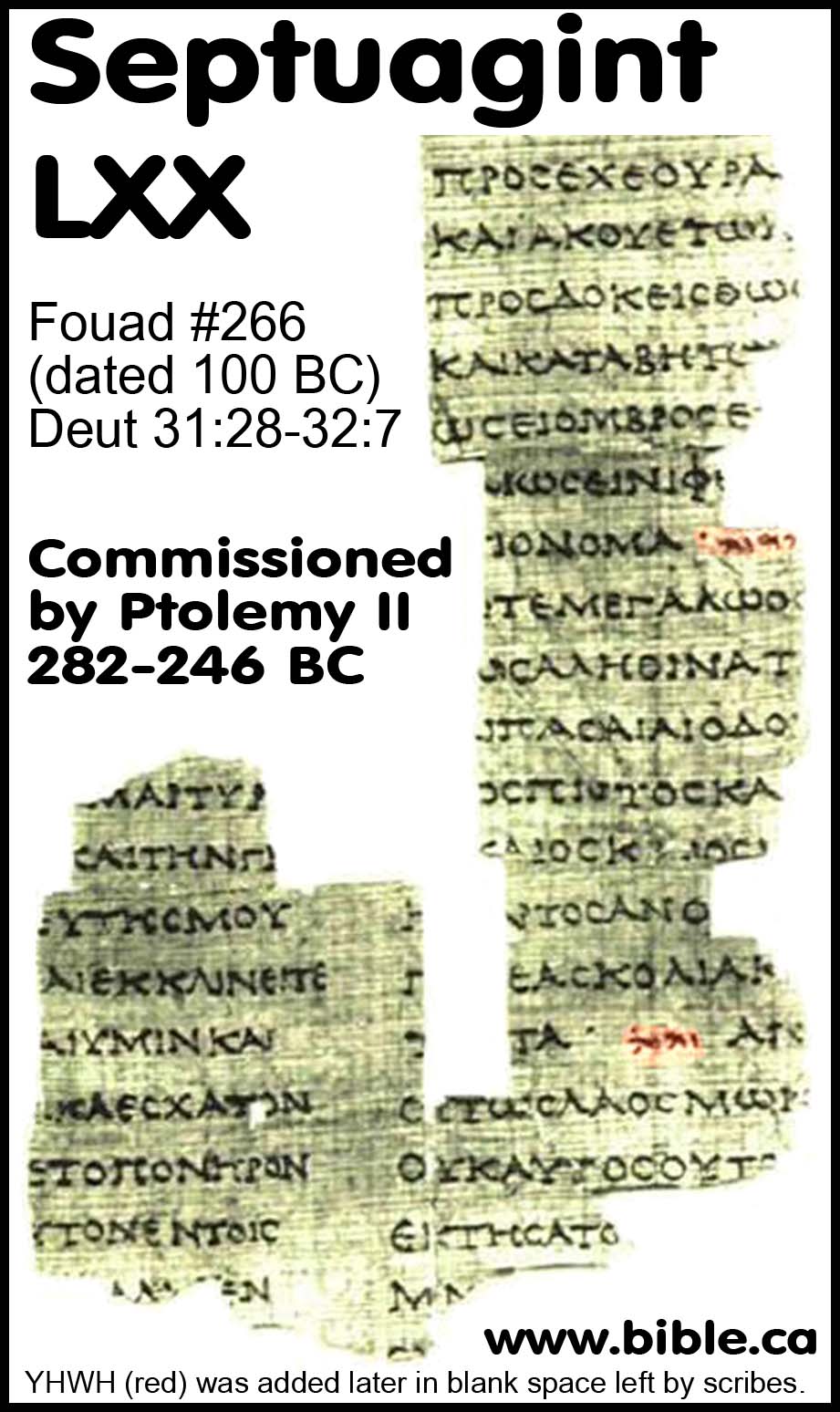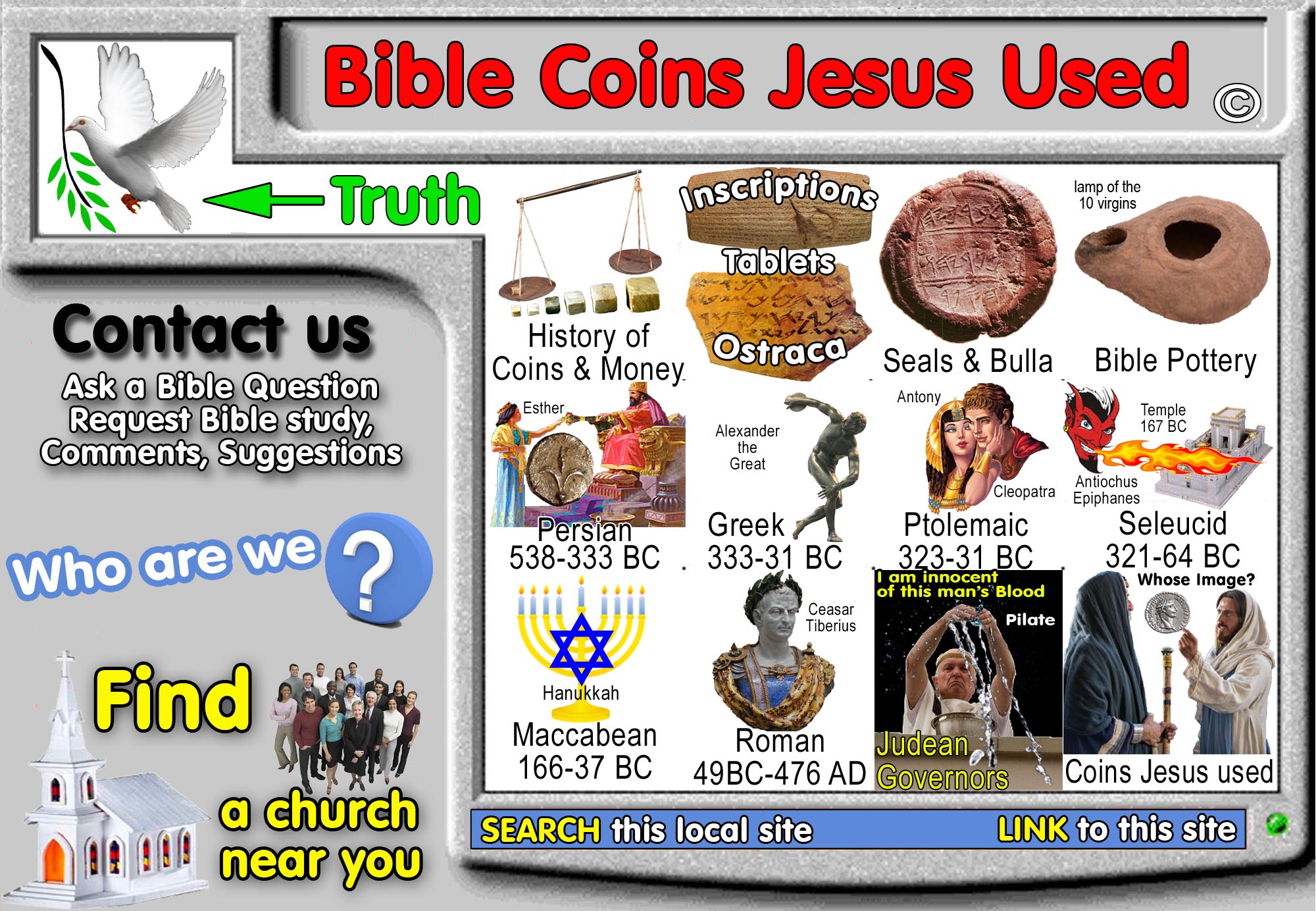Coins of the Ptolemaic Empire (Egypt): 323-31BC
|
GREEK EMPIRE COIN PAGES (333-31 BC) |
|||
|
333-302 BC |
323-31 BC |
321-64 BC |
166-37 BC |
|
|
|||
Introduction:
- Alexander the Great conquers the world in a stunning and unique series of victories:
- In 334 BC Alexander the Great defeats Darius III in the Battle of Granicus
- In 333 BC Alexander the Great defeats Darius III in Battle of Issus
- In 323 BC Alexander the Great dies at age 32 on June 10: The Great broken horn of Daniel. After Alexander the Great died, his kingdom split into four kingdoms just as Daniel had prophesied:
- "After you there will arise another kingdom inferior to you, then another third kingdom of bronze, which will rule over all the earth." (Daniel 2:39)
- "After this I kept looking, and behold, another one,
like a leopard, which had on its back four wings of a bird; the beast
also had four heads, and dominion was given to it." (Daniel 7:6)
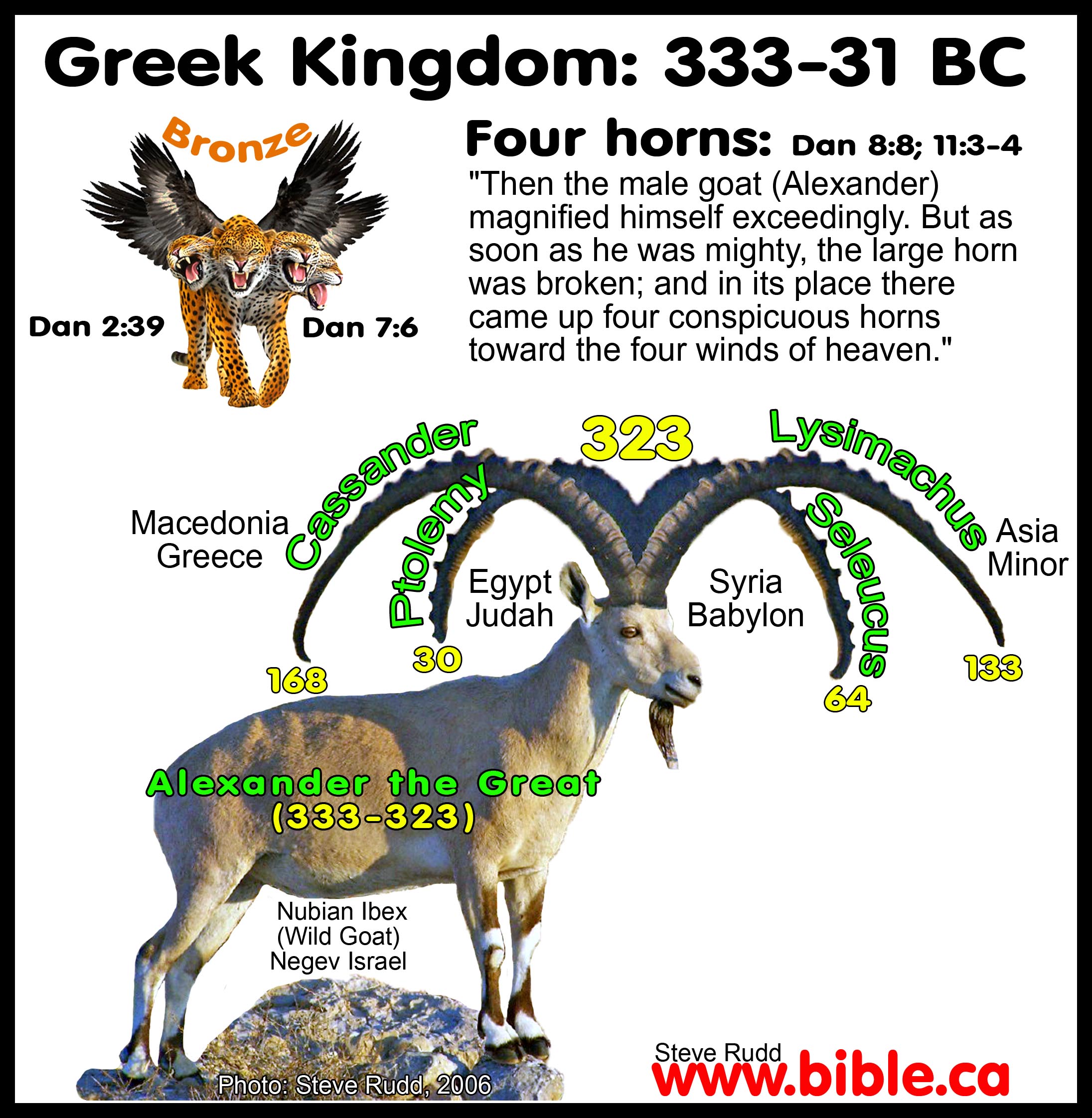
- Four horns of Dan 8:8; 11:3-4
- "Then the male goat magnified himself exceedingly. But as soon as he was mighty, the large horn was broken; and in its place there came up four conspicuous horns toward the four winds of heaven." (Daniel 8:8)
- "“And a mighty king will arise, and he will rule with great authority and do as he pleases. “But as soon as he has arisen, his kingdom will be broken up and parceled out toward the four points of the compass, though not to his own descendants, nor according to his authority which he wielded, for his sovereignty will be uprooted and given to others besides them." (Daniel 11:3–4)
- Four "horns" empires after Alexander the Great:
- Ptolemy Empire (323-31 BC)
- Area of modern Egypt
- Ptolemy Empire Ends when Rome conquers Egypt in 31 BC
- Antony/Cleopatra commit suicide 30 extincting the Ptolemy empire.
- Seleucid Empire (321-64 BC)
- Area of Modern Israel, Syria, Turkey
- Cassander (319-168 BC)
- Area of Modern Greece.
- Cassander founds Thessalonica 315 BC
- Rome conquered Greece in battle of Pydna in 168 AD)
- Lysimachus (323-133 BC)
- Area of modern Asia Minor.
- King Attalus III bequeathed Asia Minor to Rome in 133 BC
I. List of Ptolemaic kings of the Egyptian empire: 323-37 BC
- Ptolemy I (Soter) 323-282 BC
- Ptolemy II (Philadelphus) 282-246 BC
- Ptolemy III (Euergetes I) 246-222 BC4. Ptolemy IV (Philopator) 222-204 BC
- Ptolemy V (Epiphanes) 204-180 BC
- Ptolemy VI (Philometor) 180-145 BC
- Ptolemy VII (Neos Philopator) 145 BC
- Ptolemy VIII (Euergetes II Physcon) 145-116 BC
- Ptolemy IX (Soter II Lathyrus) 116-107 BC
- Ptolemy X (Alexander I) 107-88 BC
- Ptolemy XI (Alexander II) 80 BC
- Ptolemy XII (Auletes) 80-51 BC
- Ptolemy XIV 47-44 BC
- Ptolemy XV (Caesarion) 44-30 BC
- Mark Antony kills Antigonus in 37 BC ending the Ptolemaic empire.
II. Denominations, diameters and weights of Ptolemaic (Egypt) and Greek coins
- There were hundreds of coins produced during the Ptolemaic era of many varieties.
- During the earliest years of the empire, Ptolemy II (282-246 BC) for example produced a series of coin denominations in gold, silver and bronze.
- The same sets of coins were manufactured in up to four different mint cities: Sidon, Ptolemais, "Gaza" Tyre and Alexandria.
- Below is the series of coins produced at the Gaza "Tyre" mint.
- Notice the sequence of eagle motifs that progress large to small. This progression in size, weight and logical pictorial diagrams of eagles made the money easy to use and remember their value.
|
Prutah (Plural Prutot) |
1 prutah = 1 Quadran 2 lepta = 1 prutah 64 prutot = 1 denarii/drachma 256 prutot = 1 shekel |
|
Greek, Ptolemaic |
|
Half-prutah (plural half-prutot) |
1 half-prutah = 1 letpa 2 half-prutah - prutah 128 half-prutah = 1 drachma/denarii |
|
Greek, Ptolemaic |
|
Dekadrachm |
10 drachmae |
43 grams |
Greek, Ptolemaic |
|
Tetradrachm |
4 tetradrachm = 1 drachma 2 tetradrachm = 1 mina |
17.2 grams |
Greek, Ptolemaic |
|
Didrachm |
2 drachmae |
8.6 grams |
Greek, Ptolemaic |
|
Drachma (Plural drachmas) |
4 drachma = 1 Tyrian shekel 6000 drachmas = 1 talent 1 dinarii = 1 drachma 192 prutot = 1 denarius |
4.3 grams |
Greek, Ptolemaic |
|
Drachma |
6 obols |
4.3 grams |
Greek, Ptolemaic |
|
Tetrobol |
4 obols |
2.85 grams |
Greek, Ptolemaic |
|
Triobol |
3 obols |
2.15 grams |
Greek, Ptolemaic |
|
Diobol |
2 obols |
1.43 grams |
Greek, Ptolemaic |
|
Obol (Plural Obols) |
6 obols = 1 drachma 24 Obols = 1 tetradrachm 4 tetartemoria |
0.72 grams |
Greek, Ptolemaic |
|
Half-obol (plural Half-obols) |
12 Half-obols = 1 drachma 2 half-obols = 1 Obol |
|
Greek, Ptolemaic |
|
Lepta (Plural Lepton) |
1 letpa = 1 half-prutah 2 lepton = 1 quadran/prutah 7 lepton = 1 cholkos 128 lepton = 1 drachma/denarii |
|
Greek, Ptolemaic Widow gave two lepta (1 Prutot of Alexander Jannaeus) |
|
Quarter-obol |
24 quarter-obols = 1 drachma 4 quarter-obols = 1 Obol |
|
Greek,Ptolemaic |
|
Tritartemorion |
3 tetartemoria |
0.54 grams |
Greek, Ptolemaic |
|
Hemiobol |
2 tetartemoria |
0.36 grams |
Greek, Ptolemaic |
|
Trihemitetartemorion |
3/2 tetartemorion |
0.27 grams |
Greek, Ptolemaic |
|
Tetartemorion |
4 Tetartemorion = 1 obol |
0.18 grams |
Greek, Ptolemaic |
|
Hemitetartemorion |
2 Hemitetartemorion = 1 tetartemorion |
0.09 grams |
Greek, Ptolemaic |
III. Coins of Egyptian Ptolemaic Empire rulers: 323-31 BC
- Ptolemy
I (Soter) 323-282 BC
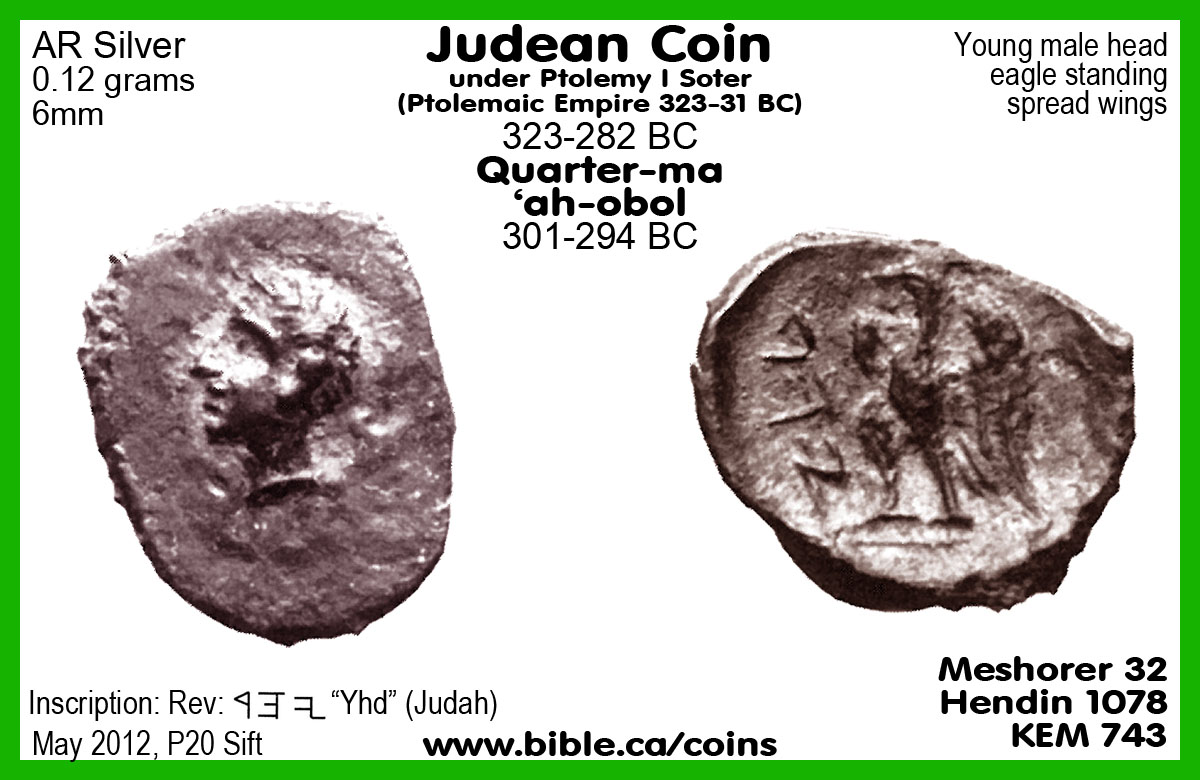
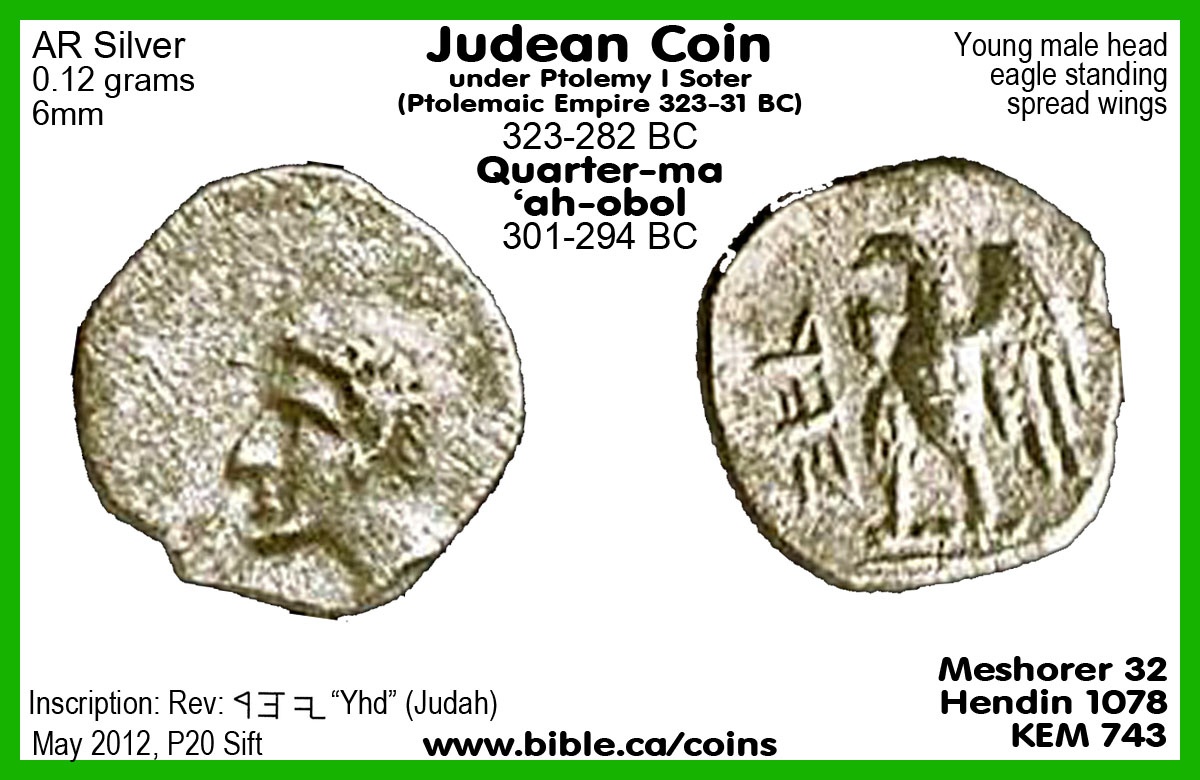
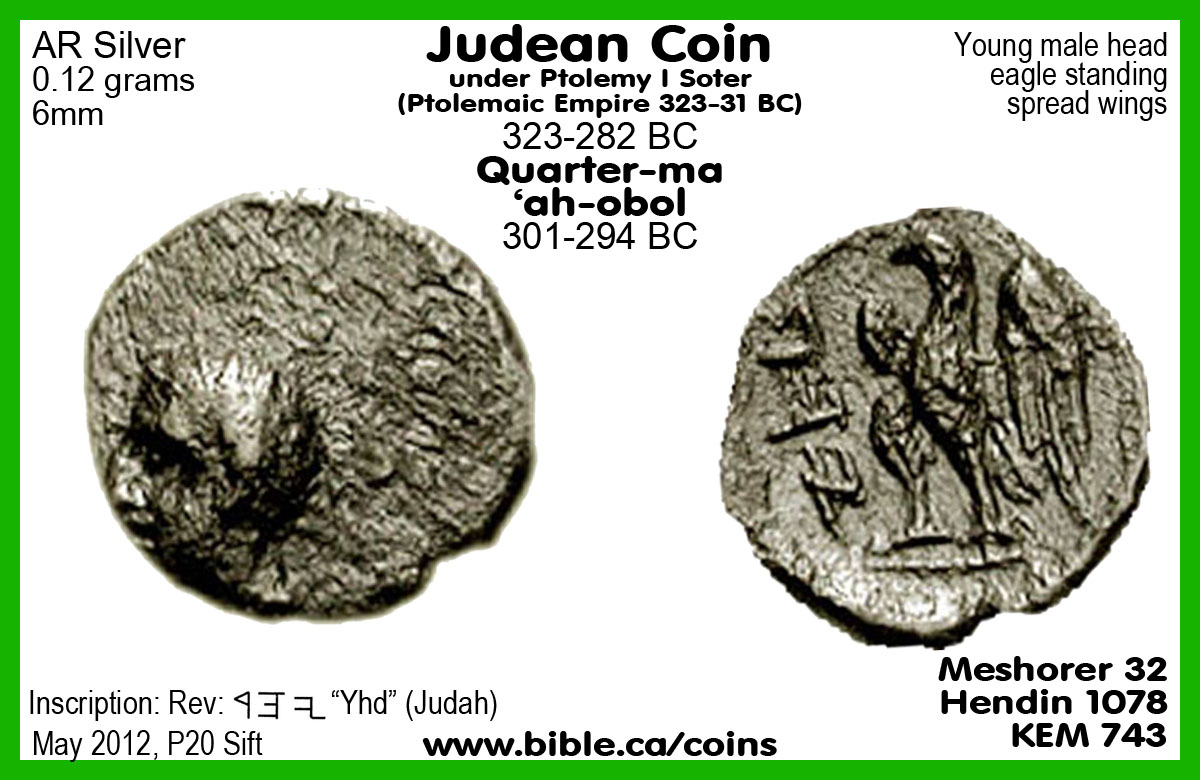
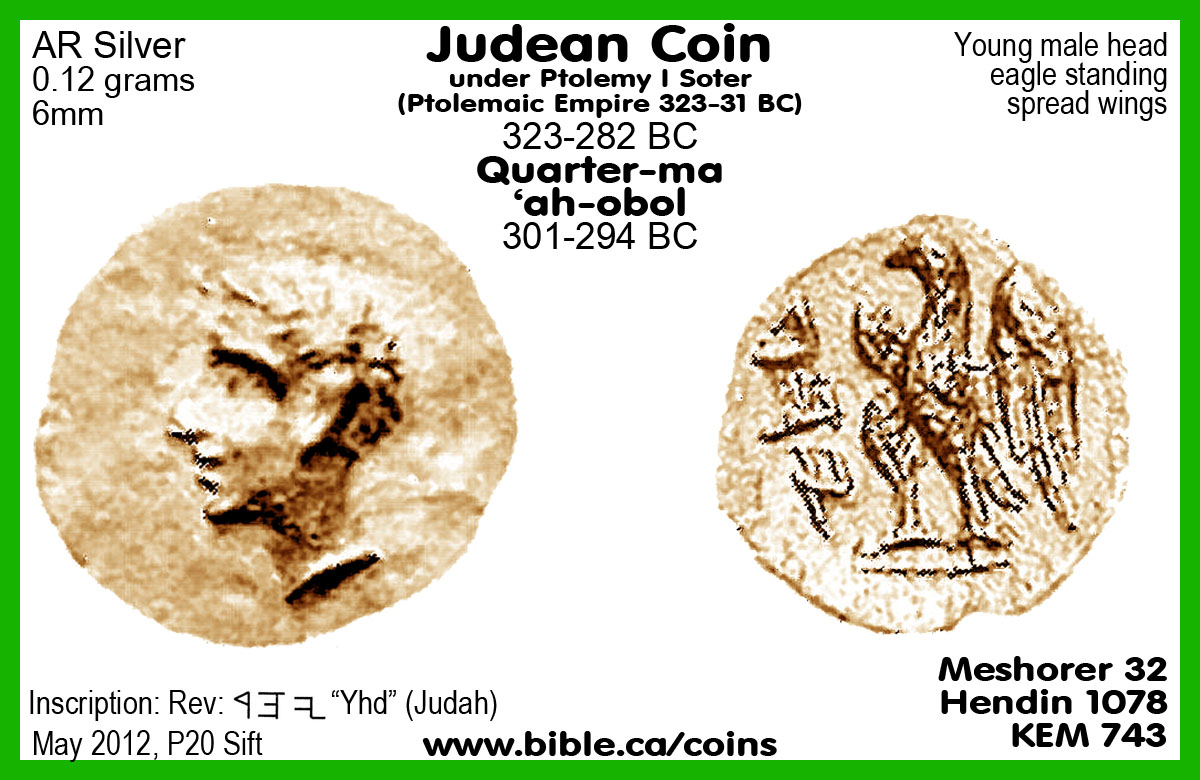
- Judean coins "YHD" coins in the early Ptolemaic empire (Egypt): "Coins 29-30: These coins too, on one side of which is seen a youthful male head and on the other an eagle, lack the characteristics of the Persian period. On the other hand they still lack certain Ptolemaic features, in particular the head of a Ptolemaic king or queen — a dominant element on their coins. In the meanwhile, until further facts are clarified, it is better to date Coins 29-30 to the transitional period of Macedonian rule in the country." (Meshorer, p 19)
- The city of Alexandria was founded by Alexander the Great in 331 BC.
- Ptolemy I builds the Alexandria Library
- Antiochus II commissions the Septuagint Manuscript of the Old Testament to be translated from Hebrew into Greek in order to place it in the Library of Alexandria.
- The library of Alexandria was destroyed by Muslims under Caliph Omar in 642 AD.
|
The same destruction of libraries and historical museums is still happening today. |
- Ptolemy II
(Philadelphus) 282-246 BC


- Ptolemy III
(Euergetes I) 246-222 BC

- Ptolemy IV (Philopator) 222-204 BC
- Ptolemy V (Epiphanes) 204-180 BC
- Ptolemy VI (Philometor) 180-145 BC
- Ptolemy VII (Neos Philopator) 145 BC
- Ptolemy VIII (Euergetes II Physcon) 145-116 BC
- Ptolemy IX (Soter II Lathyrus) 116-107 BC
- Ptolemy X (Alexander I) 107-88 BC
- Ptolemy XI (Alexander II) 80 BC
- Ptolemy XII (Auletes) 80-51 BC
- Ptolemy XIV 47-44 BC
- Ptolemy XV (Caesarion) 44-30 BC
- Mark Antony kills Antigonus in 37 BC ending the Ptolemaic empire.
IV. The Septuagint Manuscript in the Alexandrian Library
- Detailed outline on Septuagint LXX
- The city of Alexandria was founded by Alexander the Great in 331 BC.
- Ptolemy I was hostile to the Jews but founded the famous Library of Alexandria
- Antiochus II commissions the Septuagint for the Alexandria Library his father built!
- The Library of Alexandria utterly destroyed by the Muslim
conquest sometime between 642 AD.

- Having visited the modern Library in modern Alexandria, I
found it amusing and predictable that the Muslim tour guides were blaming
it destruction upon the Christians. "Muslims would never burn a
library" the guide said. Who knew? Ya Right!
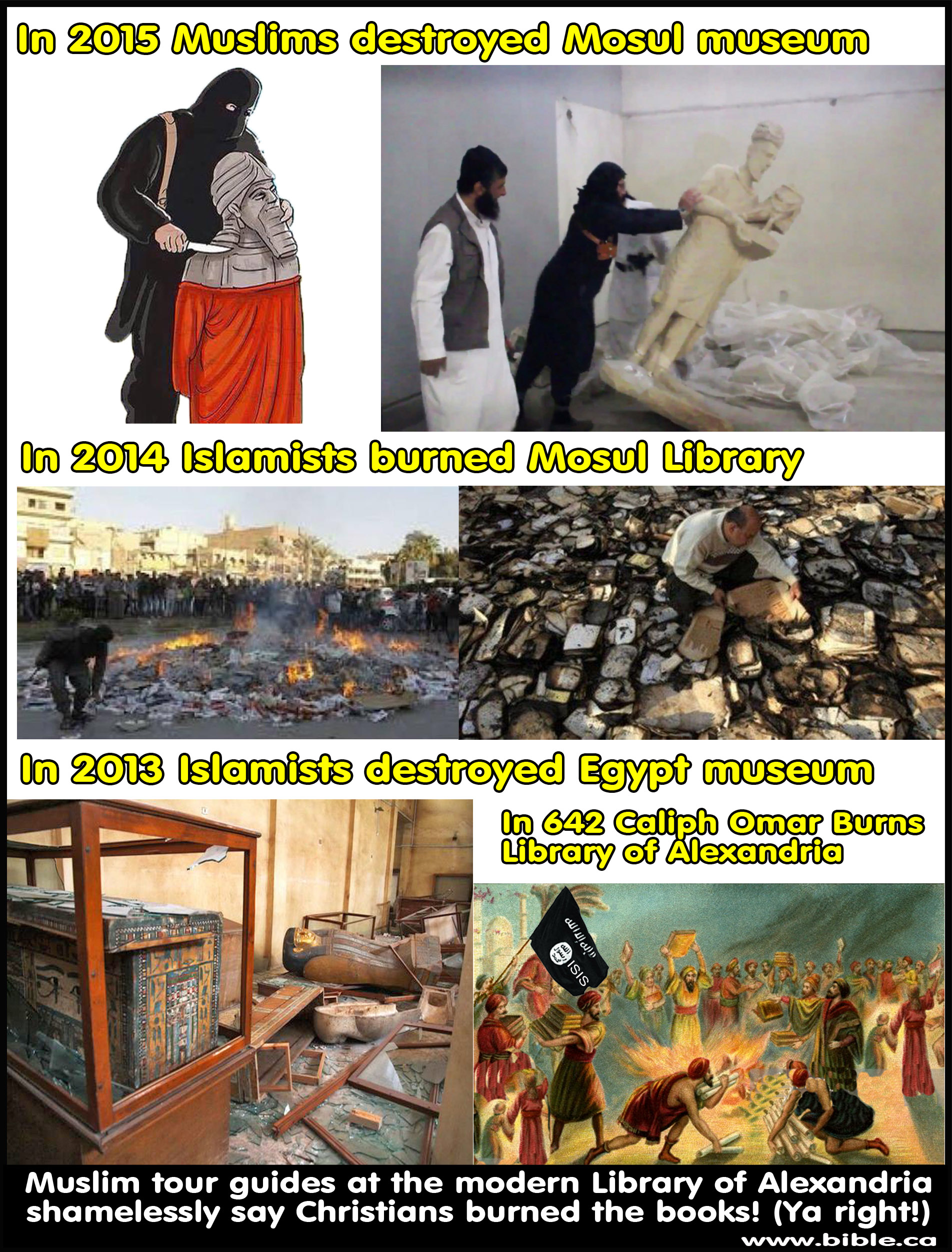
V. Muslim historical amnesia: Armenian Holocaust of 1915 AD where 1.5 million Christians were slaughtered by Muslims:
- The same re-writing of history in Igdir, Turkey, at the "Turkish" monument to the Armenian holocaust in 1915 AD where 1.5 million were told to "convert, pay the tax or die". (Sound familiar?)
- Millions were killed, beheaded and many escaped to western countries to live free of Islamic ethic terrorism.
- Of course the signage in the "Turkish" memorial in Igdir blames the killing on rebel leaders WITHIN the Christian Armenians while the Muslims prayed for peace as mere observers. How utterly ridiculous!
- “Turkification”: social engineering that erases non-Muslim history, invents a new fictional past which blames the Armenian Genocide of
- 1.5 million Christians on Armenian Christians as Muslims sat innocently on the sidelines and prayed for peace.
- New York Times said: "The Armenian massacres were wiped from the country’s history. A Century After Armenian Genocide, Turkey’s Denial Only Deepens Nearly 1.5 million Armenians died at the hands of the Ottoman Empire in 1915, during World War I. Turks by and large do not believe mass killings were planned. Turkey’s ossified position (denial), so at odds with the historical scholarship, is a legacy of how the Turkish republic was established after World War I. Under its founder, Mustafa Kemal Ataturk, society here underwent a process of Turkification: a feat of social engineering based on an erasure of the past and the denial of a multiethnic history." (NYT, April 16, 2015)
|
Armenian Genocide 1915 AD 1915 - 2015 100 years of Muslim lies
"The Muslim Holocaust Memorial in Igdir, Turkey is like the proposed ISIS Holocaust Museum of ISIS Muslims killed by Christians in Mosul in 2014."
This is the official Turkish Governments plaque in the Igdir memorial of the 1915 Armenian Genocide which says the Armenians killed 1.5 million of their own people and innocent Muslims. Classic “Turkification” in action.
Click to view image in high resolution |
- So when you visit the new modern Library of Alexandria in Egypt today and the tour guides tell you Christians burned down the library, just print this picture off and hand it to them. When have Christians been known to ever burn libraries? But we see Muslims engaging in deliberate misinformation campaigns that rewrite known history AND BURNING DOWN LIBRARIES AND MUSEUMS TODAY.
- Remember, the were many important documents and
manuscripts in the Library of Alexandria that the Devil wanted to get rid
of and he used Muslims as his agent.

Conclusion:
1. The Greek kingdom existed from 333 - 31 BC
2. Alexander the Great lived only ten years and ruled the world as a sole monarch from 333-323 BC
3. The early Greek/Macedonian period is 333 - 302 BC as far as classifying coins is concerned.
4. After Alexander the Great died, his kingdom was split into four Kingdoms: (Four "horns" empires after Alexander the Great)
- Ptolemy Empire (323-31 BC)
- Seleucid Empire (321-64 BC)
- Cassander (319-168 BC) We do not discuss this kingdom at all because it is far removed from land of Judah.
- Lysimachus (323-133 BC) We do not discuss this kingdom at all because it is far removed from land of Judah.
- For a short time during the Greek Empire period, the Jews gained true independence under the Maccabees (Hasmonean Era): 166-37 BC
- Rome conquered all by 31 BC and the fourth and final kingdom of Daniel's prophecy (Dan 2) came into existence.
- On Pentecost 33 AD, God set up his divine Kingdom which we know today as the Church of Christ which will never come to an end:
- "For this you know with certainty, that no immoral or impure person or covetous man, who is an idolater, has an inheritance in the kingdom of Christ and God." (Ephesians 5:5)
- "For He rescued us from the domain of darkness, and transferred us to the kingdom of His beloved Son, in whom we have redemption, the forgiveness of sins." (Colossians 1:13–14)
- Why not attend a local church that follows the pure Bible Blueprint in your own home town! Click here to find one
|
GREEK EMPIRE COIN PAGES (333-31 BC) |
|||
|
333-302 BC |
323-31 BC |
321-64 BC |
166-37 BC |
|
|
|||
By Steve Rudd: Contact the author for comments, input or corrections.
